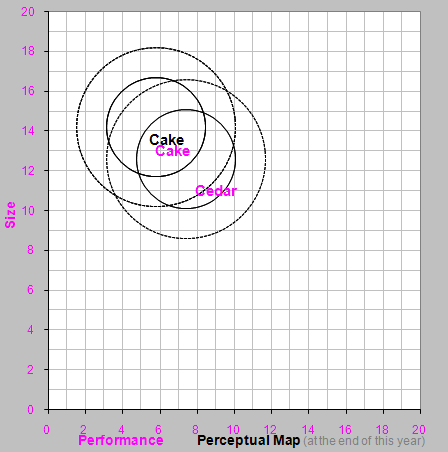13.3 Broad Cost Leader - Practice Round 2
Practice Round 2
R & D Round 2
Cake - Improve positioning and reduce age. Reduce reliability (MTBF) to reduce material cost. Example: Increase Cake's performance to 6.7, reduce size by 13.0, and reduce MTBF to 17000.
New Product - Note that the new product's row is yellow instead of green, and that you cannot change these cells. This is because your product will not emerge from R&D until its current project completes. Under the rules of the simulation, new R&D projects cannot begin until the old one completes.

Marketing Round 2
Cake - Offer a price cut to $32.50. Hold promotion and sales budgets near current levels. Cake will still sell to both Low Tech and High Tech customers. Enter a forecast of 1100.
New Product - Price at $44.00, Promotion at $1000, Sales at $1000. Since Cedar won't be ready to enter production until well into this year, so enter 200 for sales forecast.
Production Round 2
Schedule production using the formula:
(Unit Sales Forecast X 1.15) - Inventory On Hand
Important: As your new product is coming out sometime during the year, you might not be able to use the above formula - new products cannot begin production prior to their revision (release) date. Should the number you enter into the production schedule turn red, reduce the schedule until the red number turns black.
Cake - Increase automation by 1.0 or 2.0 points.
New Product - Increase automation level, but only by 1.0 points. We will want to begin repositioning it next year in order to keep it fresh for High Tech customers. The higher the automation rating, the more difficult it is to reposition. We must strike a balance between our cost pressure requirements vs. our need to reposition often.
Finance Round 2
Match your plant investment with a long term debt (bond). If you do not have sufficient new bond debt capacity, issue stock to cover the shortfall.
Look at the proforma balance sheet, and add together your Cash and Inventory accounts. Apply the following rule of thumb. Keep between 15% and 20% of your balance sheet assets in Cash plus Inventory. You do not care about the mix, but you do want to have adequate reserves to cover unexpected swings in inventory.
Adjust your cash position to meet the above guidelines. If you are cash rich, pay dividends and buy back stock.
Do not issue current debt.
Save decisions (select "directly to the website").
